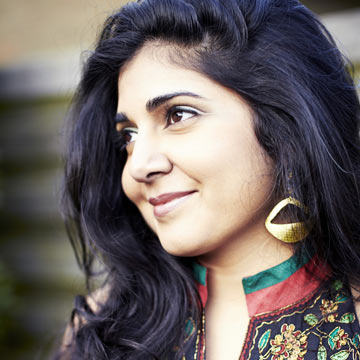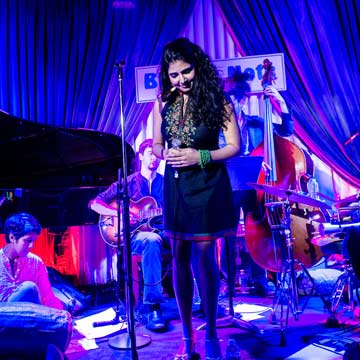Talk Time: The Multicultural Musician

(Photo: Julien Charpentier)
Jazz vocalist and composer KAVITA SHAH incorporates music from around the world—as in Interplay, her latest album. After earning a bachelor’s degree in Latin American Studies at Harvard, she worked as a journalist and at nonprofits. But the call of music was irresistible. Her compositions and style are informed by her eclectic outlook and upbringing.
What would you say is the most common misconception
about jazz that people who don't know
much about it assume?
Jazz has become a very nebulous word for a long
time. Is Ella Fitzgerald jazz? Is it Louis Armstrong?
When you get into what's happening in the jazz world
today, it sounds nothing like this kind of classic jazz
and really reflects many more decades of development.
One of the elements is having the talent of improvisation, of being a skilled enough musician that you're able to create on the spot, and that makes jazz music different. It is being completely in the moment. And it's almost a spiritual experience.
You seem to have worked your Indian heritage
into your music without being labeled as an Indian-American musician. You are known as a multicultural
artist. How did you manage that?
I think that's kind of a lifelong question. The one
geographic identity that I can say I claim is being a New
Yorker. I feel that above being an American, I feel that
above being an Indian. I'm a New Yorker. That's who I
am. I grew up next to the United Nations. My family
and their outlook on the world as well as the things I
was exposed to shaped me. I grew up singing in a choir
called the Young People's Chorus of New York City; it's
a professional children's choir. And we sang in over
20 languages in many different styles: we would sing
Gospel and also sing classical music, and in Carnegie
Hall. There was an exposure that made me feel comfortable
among that kind of diversity and richness.
I think there is this thread of Indian culture that is cosmopolitan that gets lost in the binary story of Indian integration. And you know, we have some stereotype of what it really means to be Indian. You don't have to wear certain clothes and speak a certain language and dance in a certain way to be Indian.

(Photo: Jason Gardner)
You talk not just about the pursuit of virtuosity,
but of the use of your work as one of the cornerstones
for promoting cultural dialog. Was that something
that you always set out to do as your mission?
It is who I am, you know, these multiple identities
with my research (in Latin American Studies) and my
fluency in different languages, my travels, I am all these
things. I actually think in many ways my experiences
with different cultures has helped me to appreciate
and understand my own. It's my life, you know, where
all those things live together and I only feel comfortable
with all of these diverse elements being together.
I think I would feel very uncomfortable if I walked into
a room of people where everybody was homogenous.
You mentioned your family’s outlook helped
shaped you as well. Are you able to tease that out?
They really espoused values of multiculturalism in
the arts. My parents were both from Bombay; my grandfather
was the first person to bring American books to
India in the 1940s. So he actually came to New York in
the forties, way before the ‘70s wave of immigration. He
worked in the book business, and my dad worked with
him. There were a lot of books around the house and
there was a real value and appreciation for literature
and culture. Music, not so much. I brought that into the
mix. They gave me the opportunities to explore it.
It's taken me actually until now to really feel Indian. I just actually visited my ancestral villages in Gujarat and I had never been there before. It felt like I was going to a village in Brazil or in Africa except I was finally coming home. It sort of all made sense—this is where I'm from and this is who I am and it feels very good.
What advice would you give to kids who want to
follow their heart as you did?
Life is short. Strive to chase your own dreams and
not someone else’s, or you might never be at peace.
If you are creative, remember that we live in a world
where art is much needed but grossly undervalued. To
succeed, you must be willing to fail, and find strength
not in others’ praise, but in your own practice.

Poornima Apte is a Boston-area freelance writer and editor. Learn more at WordCumulus.WordPress.com.
Enjoyed reading Khabar magazine? Subscribe to Khabar and get a full digital copy of this Indian-American community magazine.
blog comments powered by Disqus










